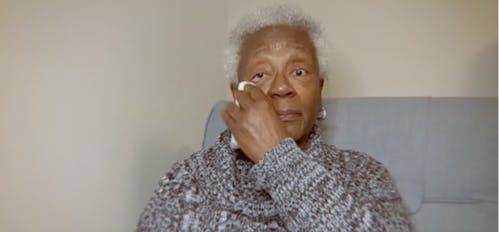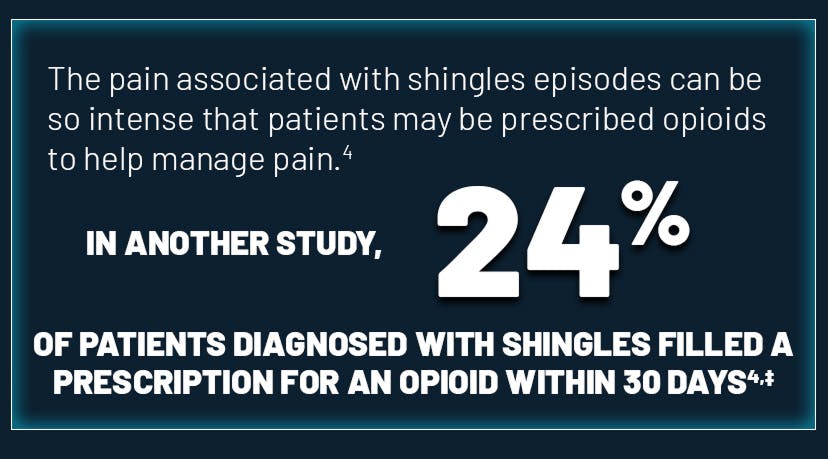You are about to leave a GSK website
You are about to leave a GSK website. By clicking this link, you will be taken to a website that is independent from GSK. The site you are linking to is not controlled or endorsed by GSK and GSK is not responsible for its content.
Paul’s Passion. UNRAVELED BY SHINGLES.
The pain during a shingles episode can be excruciating and interrupt your patients’ activities.1,2
Patients have described shingles as burning, stabbing, or shocklike1
Shingles pain can interfere with a person’s ability to perform daily activities. Even gentle touch can be painful for most patients with shingles.2
The rash typically lasts 7 to 10 days, with complete healing in 2 to 4 weeks.3
The pain of shingles was so intense that it affected Vanessa’s ability to do simple tasks like brushing her hair.
“I would rather have my 2 children again than go through this pain.”
-Vanessa, age 65
Real person who had shingles. Other people’s experiences may be different.

Vanessa, age 65
More rash reality videos
In studies, more than 70% of patients with shingles received medication to treat their pain.2,*,†

- *
Data from a post hoc analysis of 2 phase 3 trials of participants in the placebo groups with a confirmed case of herpes zoster (HZ) in adults ≥50 years old (N=280) and ≥70 years old (N=240).2
- †
Most frequently used medications to treat pain by anatomical therapeutic chemical (ATC) class included analgesics, such as acetaminophen (60.8% in adults ≥50 years of age [YOA] and 45.4% in adults ≥70 YOA), anti-inflammatory and antirheumatic products, such as ibuprofen (37.5% in adults ≥50 YOA and 22.9% in adults ≥70 YOA), antiepileptics, such as gabapentin (20.8% in adults ≥50 YOA and 20.4% in adults ≥70 YOA), and psychoanaleptics, such as amitriptyline (3.3% in adults ≥50 YOA and 7.5% in adults ≥70 YOA).2
- ‡
Data from a retrospective observational study assessing three insurance claims databases in the US. The study included beneficiaries 18-64 years (commercial and Medicaid) and beneficiaries 65 years and older (Medicare) who were diagnosed with incident herpes zoster (HZ) during 2007-2021. A total of 3,543,270 patients had an incident episode of HZ, among whom 2,595,837 (73%) had no opioid claim in the prior 6 months (“opioid-naive”). Among the opioid-naive patients, a total of 623,515 (24%) filled a prescription for an opioid within 30 days following HZ diagnosis. The percentage with an opioid claim declined over time during 2007-2021. Given some patients may have been included in more than one data source, the investigators were unable to determine overlap among databases. In addition, the exact reason for the opioid prescription was unable to be determined with certainty.4
For some, shingles can lead to potential complications that can be serious1
See how you and your staff can start a shingles conversation with your appropriate patients.
References
- Harpaz R, Ortega-Sanchez IR, Seward JF; Advisory Committee on Immunization Practices (ACIP) Centers for Disease Control and Prevention (CDC). Prevention of herpes zoster: recommendations of the Advisory Committee on Immunization Practices (ACIP). MMWR Recomm Rep. 2008;57(RR-5):1-30.
- Curran D, Matthews S, Boutry C, Lecrenier N, Cunningham AL, Schmader K. Natural history of herpes zoster in the placebo groups of three randomized phase III clinical trials. Infect Dis Ther. 2022;11(6):2265-2277.
- Shingles symptoms and complications. Centers for Disease Control and Prevention. April 19, 2024. Accessed May 21, 2024. https://www.cdc.gov/shingles/signs-symptoms/index.html
- Dooling K, Leung J, Bohm MK. Prescription opioids following herpes zoster: An observational study among insured adults, United States, 2007-2021. J Opioid Manag. 2024 Jul-Aug;20(4):319-328.
